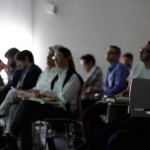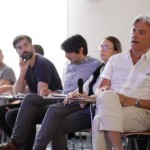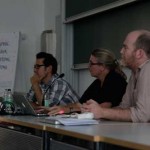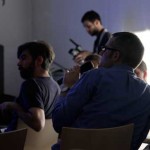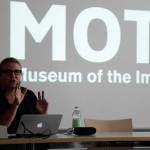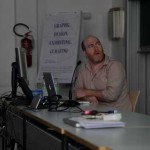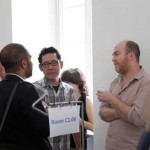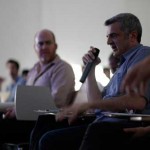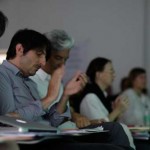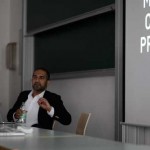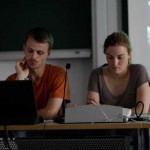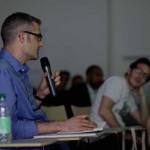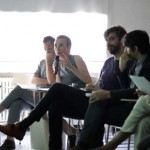
Wide White Space (The Way Beyond Art) was an exhibition held in 2011 at the CCA Wattis Institute in San Francisco – aimed at investigating ‘graphic design’s evolving relationship with the practice of exhibition making as it intersects with the visual arts and the work of both artists and curators’ –, a series of lectures, and a series of small exhibitions curated by students, each devoted to the work of a graphic design team. Wide White Space (The Way Beyond Art) is now a book that documents and illustrates all these activities. The book will be launched on August 1 (and available soon to order from the website http://widewhitespace.net).
As the curator of the project, Jon Sueda, explained in the talk he gave at the conference we organised in Bolzano last month, the Wide White Space exhibition emerged from a personal motivation, being himself a graphic designer who is engaged in the exhibition context, in issues of exhibition design and making, collaborating with curators, artists and art institutions. Also, being a designer who, since he left school, has organised a number of exhibitions as a means to gather people together, as well as to produce and discuss works. (Sueda also confessed he feels uncomfortable to be called ‘curator’, feeling rather an amateur.)
Beside the personal motivation of Sueda, the idea of organising the exhibition was actually born within the CCA Wattis Institute of Contemporary Art in San Francisco, of which Sueda is art director since 2007. The Wattis is an institution that not only presents international contemporary art but is also a special forum of reflection and discussion on curatorial practice. The Institute is directed by Jens Hoffman, a curator who also teaches at CCA and who is co-editor of “The Exhibitionist”, a journal ‘made by curators for curators’, entirely focused on exhibition making and curatorial studies. (The design of the journal, which references the “Cahiers du Cinéma”, is by Sueda.)
It is in the framework of its ongoing investigation of exhibition making that, in 2010, the Wattis decided to launch a series of exhibitions entitled The Way Beyond Art that aim at approaching ‘the subject of curation and exhibition making through non-fine art subjects,’ thus opening to disciplines such as industrial design, architecture, film, literature and graphic design: all disciplines that ‘have their natural places outside the gallery but are increasingly finding their way into the exhibition space,’ in the words of Claire Fitzimmons, deputy director of the Wattis Institute (see her introductory essay to the publication Wide White Space).
As concerns graphic design, the exhibition held in 2011 was curated by Sueda in collaboration with the CCA’s Undergraduate Program in Graphic Design and the Graduate Program in Design. The exhibition’s scope included the diverse relationships that link graphic design and designers with exhibition making. A number of international works, institutions and designers – mainly, although not exclusively, from Europe – were selected to exemplify three themes: 1. innovative graphic design identities created for [art] exhibitions and institutions; 2. works resulting from the unique collaboration of graphic designers with artists and curators; 3. exhibitions and time-based projects initiated by graphic designers. A criterion for selecting the designers, according to the curator, was that they ‘consciously construct a narrative around their work, position themselves as authors of autonomous creative projects, and maintain a conceptually rigorous, research-based, historically fortified approach.’
The exhibition was organised using different display approaches. Two rooms presented graphic design artefacts and ephemera in a traditional way, on walls and in vitrines – including, among many other projects, the identities of Casco (Utrecht) by Julia Born and Laurenz Brunner, of the Boijmans van Beuningen Museum by Mevis and Van Deursen, of the Walker Art Center (Minneapolis), and of the Stedelijk Museum (Amsterdam). The other three galleries, instead, were devoted to display works of designers acting as curators of projects, be they in the gallery space, in their home, or via the Web. In this second part of the exhibition, the curator decided to re-stage time-based projects as well as exhibitions previously held elsewhere, actually creating an exhibition of exhibitions – including Julia Born’s Title of the Show and Experimental Jetset’s Kelly 1:1.
The presentation of the exhibition, the list of graphic designers and institutions whose work was on display, and images from the show are all available online.
The book Wide White Space offers now a more extensive documentation of the entire project, including interesting essays.
The first 64 pages feature the Foreword by Fitzsimmons, a collage of short interviews with Jon Sueda, the catalogue of designs and designers on display – each introduced by a text and illustrated by an image –, and a text by Project Projects about exhibition design and graphic design exhibitions (Project Projects are among the designers featured in the show.)
The second part of the publication, Wider White Space (marked by a different paper and printed in two colours), documents how the Wide White Space exhibition was developed into a wider program of activities focused on exhibition making and graphic design. This program included a series of talks given by faculty from the undergraduate and graduate programs of the CCA, a special course lead by Sueda and the series of small exhibitions that resulted from the course, curated by the students and each devoted to the work of a graphic designer or team (APFEL, Experimental Jetset, Walker Art Center, Project Projects).
Overall the texts included in the book provide a varied collection of perspectives on graphic design, the exhibition context and the curatorial, and on their intersections.
Close Encounters, by Project Projects, is structured in five paragraphs: Presentation, Action, Confusion, Distribution, Contextualization. The first paragraph deals specifically with the exhibition of graphic design: Why exhibit graphic design and graphic artefacts in a physical context? Why do so at a time when museums and institutions show an increasing interest in virtual mediation of contents and of the visitor’s experience? By briefly reviewing the aims and approaches of graphic design exhibitions held in the recent years – from site-specific installations by designers to the exhibition of existing designs and artefacts – the authors conclude that ‘[i]t’s almost as if, in the decades of desktop publishing and cloud computing […] the field has become so virtual that now the job of graphic design exhibitions is to bring the work itself back down to Earth.’ The following three paragraphs of the essay discuss the social quality of exhibitions and how exhibition design can contribute to engage the public; the confusion of roles and functions that occur between artistic practice and exhibition design, between what is on display and the display structures, and between the exhibition itself and its documentation; the (limits and richness of the) distribution, representation and mediation of exhibitions over space and time. Finally, the Authors consider one of the most critical issues regarding graphic design in the gallery: the contextualisation of something, design, that is ‘meant to be viewed in some “real world” context’ and not in the white cube. Project Projects illustrate some alternative strategies to deal with this issue.
In her essay, ‘With Every Movement… The Impression Changes’, Emily McVarish carefully reconsiders the work of El Lissitzky as a figure that is particularly worthy of consideration in the light of contemporary graphic design and, she argues, specifically of the kind of works selected for the Wide White Space exhibition. The creation of exhibitions was central to Lissitzky’s practice, as was his interest in creating dynamic situations. McVarish focuses on some works from the 1920s that exemplify the evolving graphic approach to the exhibition space: the Proun, the Proun Room, The Room for Constructivist Art, the Abstract Cabinet and the Soviet Pavilion at the Press fair. These works show how Lissitzky used the design of the exhibition dimensions (surface, space and time) to empower the viewers’ movement, to make them active and engaged, thus anticipating participatory forms of art and of interactive design.
Rachel Berger, a graduate from Yale, illustrates the problems of exhibiting graphic design through the case of the Yale MFA Graphic Design Show: Twenty years of shows since the 1980s, when Sheila Levrant de Bretteville took on the organisation of the department of Graphic Design, housed in the Art and Architecture Building designed by Paul Rudolph, up to the shows held in the new venue Green Hall, where the Yale School of Art moved in 2000. In particular Berger points out how, in the new millennium, the focus of attention of students has shifted from making their works look good to address conceptual issues, adopting a more curatorial approach to the organisation of the shows: ‘From “Does my book look good?” to “Does it make sense to include my book?”’. The Author illustrates three attitudes which have characterised the recent years of the shows at Yale: to question all assumptions, to focus on a main, single, concept, and to impose restrictions. Finally, Berger tells the story of the graduation show that she and her colleagues set up in 2009 – Lux et Veritas. Not concealing the difficulties the group of students faced in the process of curating and making the exhibition, Berger explains how they finally opted for a video presentation of their works in the gallery setting.
MacFadden & Thorpe similarly offer a personal look into the meaning that exhibitions have for designers, and especially on the relevance that the exhibition context may have for designers who, like them, are used to make also work for their own expression and are interested in producing site-specific works. Seeing graphic design in the context of galleries, they write, ‘makes you feel that as a practitioner, what you do has some cultural relevance,’ that it gains some aura, and it can get more focused critical attention. Through examples drawn from their experience as well as from other designers’ works – such as projects by Stefan Sagmeister and Geoff McFetridge, specifically designed for the gallery display –, as well as from the Wide White Space exhibition, MacFadden & Thorpe support the gallery as a place that can offer both historical design and contemporary design a context for study and appreciation.
The last essay in the book, is by Eric Heiman (founding partner of Volume Inc.), A Meditation on Space (In Four Parts). The topic he deals with is one that comes up, here and there, in the other essays too: The physical and social nature of exhibitions and of the exhibition space and experience. First Part illustrates the importance of activating the space and underlines the role that design can have in building experience within it. Second Part focuses on art spaces and galleries, just to shift the attention to art projects that have rather taken place outside white cubes, right in the streets, struggling to engage the public and to foster people’s active participation. Part Three turns to graphic design, with some examples of works by Heiman and Volume Inc. that have sought to include ‘participation, tactility and the experiential.’ Part Four considers how in the recent years communication and experience ‘have totally converged’ and raises some doubts on the benefits of having technology all around us, mediating our experience of the world, of objects, space, and relations: ‘Sometimes, silence … is the best design solution of all.’ (The text of Eric Heiman is also available online at http://blog.sfmoma.org.)


